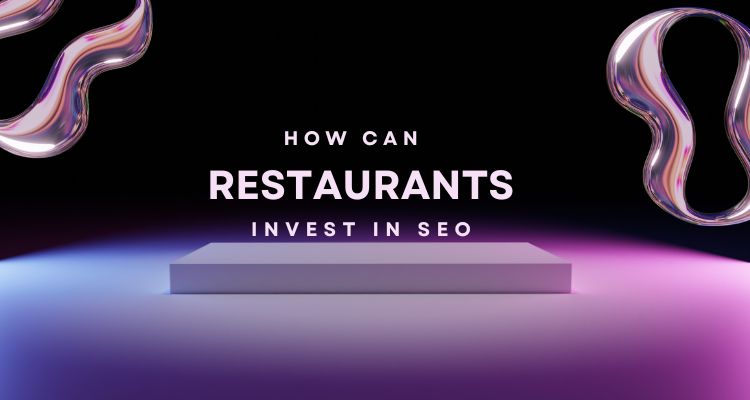Running a restaurant in 2025 isn't just about flavor — it's about visibility. Your chef might whip up a mouthwatering birria taco or a five-star vegan ravioli, but if your business doesn't show up on Google when someone searches "best restaurant near me," you're invisible.
That's where SEO (Search Engine Optimization) comes in. Most restaurant owners think SEO is just for tech companies or bloggers. The truth is that local SEO can make or break a restaurant, especially in competitive cities or delivery-focused towns.
In this article, we'll break down how restaurants can invest in SEO smartly — no fluff, no fake promises — just real strategies that bring people through the door (or onto your delivery app).
What is SEO for Restaurants?
SEO is how you show up online, specifically on search engines like Google. But for restaurants, it's less about ranking for "best Italian food recipe" and more about dominating local, high-intent search terms like:
- "Best pizza in Austin"
- "Vegan brunch near me"
- "Outdoor seating restaurants are open now"
When people search for those, Google doesn't just show websites — it pulls up Google Business Profiles, local maps, menus, reviews, photos, and more. Your job? Own those spots.
Why Should a Restaurant Even Bother with SEO?
Let's be real — restaurant margins are tight. Every dollar has to prove ROI. But SEO isn't an expense. It's an asset.
Here's what SEO does for restaurants:
- Boosts reservations and walk-ins: 93% of consumers look up restaurants online before dining. Be the place they find — not your competitor.
- Builds credibility via reviews and local presence: Ranking high signals trust. More reviews? More bookings.
- Captures mobile users looking for food right now: "Near me" searches are exploding, and you want to be the one who shows up when someone's hungry.
- Drives takeout and delivery orders: Organic search is a goldmine for food delivery traffic and is less expensive than paid ads over time.
How Can Restaurants Start Investing in SEO?
Let's break this down like a tasting menu — step by step.
1. Claim and Optimize Your Google Business Profile
This is non-negotiable. Your GBP is your digital storefront.
- Add real photos (interior, dishes, team)
- List up-to-date hours, menu links, and services (takeout, delivery, dine-in)
- Respond to reviews (even the spicy ones)
- Use keywords in your business description (e.g., "family-owned Lebanese restaurant in downtown LA")
Pro Tip: Use Google Posts weekly to share specials or events — they help SEO and engagement.
2. Get a Website (That Works)
Yes, you need a website. No, it doesn't need to cost $10k.
But it must be:
- Mobile-friendly
- Fast-loading
- SEO-optimized (H1s, meta tags, schema markup)
- Integrated with online reservations or delivery (OpenTable, DoorDash, etc.)
We can help you build a professional, conversion-focused website that's made specifically for restaurants, not some generic template site. Whether you're launching your first location or upgrading from a clunky old page, WebCraftio can design and develop a high-performing site tailored to your brand.
Book a free strategy call with our team, and let's map out the perfect web presence for your restaurant.
3. Local Keywords = Local Customers
What's the point of ranking globally if your customer lives three blocks away?
Use keywords that include:
- Neighborhood and cuisine
- "Near me" variants
- Menu highlights (e.g., "best gluten-free pizza in Brooklyn")
You can start with free tools like Google Keyword Planner or get serious with Semrush. Or partner with a team like WebCraftio to skip the learning curve.
4. Nail Your On-Page SEO
Every page of your site — especially your homepage, menu, and contact page — needs:
- Title tags and meta descriptions
- Alt text on images
- Internal linking (linking your pages together)
- Schema markup for restaurants (Google eats this up)
This stuff is technical but powerful. The kind of work WebCraftio delivers daily.
5. Create Local Content
Blogging sounds like a lot, but even two posts a month can move the needle. Try:
- "5 Must-Try Dishes in New York"
- "How We Source Our Ingredients from Local Farmers"
Local content builds authority and trust and gives Google fresh pages to index. It also helps with voice search. Think: "What's a good seafood place open right now?"
6. Get Reviews. Reply to All of Them.
Reviews are strong ranking signals. You want lots of them, and you want them to be authentic.
- Ask customers at the table or via follow-up emails
- Train staff to casually mention it
- Respond to every review. Yes, even the bad ones
Reviews also give you content and feedback. Win-win.
7. Stay Consistent Across Platforms
Name, address, phone number (NAP) — keep it identical on:
- Your website
- Yelp
- TripAdvisor
- Uber Eats, DoorDash, and delivery apps
Inconsistencies confuse Google and its customers. Clean data = better rankings.
So… How Much Should Restaurants Invest in SEO?
Here's the unfiltered truth:
- DIY SEO (if you're time-rich): $0–$100/month (tools, templates, time investment)
- Done-for-you SEO (WebCraftio style): $500–$2000/month depending on your goals
- One-time SEO setup: $750–$1500 for a full audit, fixes, and optimization
Remember: SEO is compound growth. It keeps working long after you stop spending. Invest early, and you'll outrank competitors who are stuck boosting Facebook posts that vanish in 24 hours.
Final Word: SEO Is the Secret Sauce for Modern Restaurants
SEO isn't optional anymore — it's your online visibility engine. Whether you're a family-owned diner or an upscale sushi lounge, the question isn't if you should invest in SEO. It's how soon?
Ready to bring your restaurant into the digital spotlight?
WebCraftio is your growth partner — from strategy to execution.
Let's talk about your restaurant's SEO strategy today.
